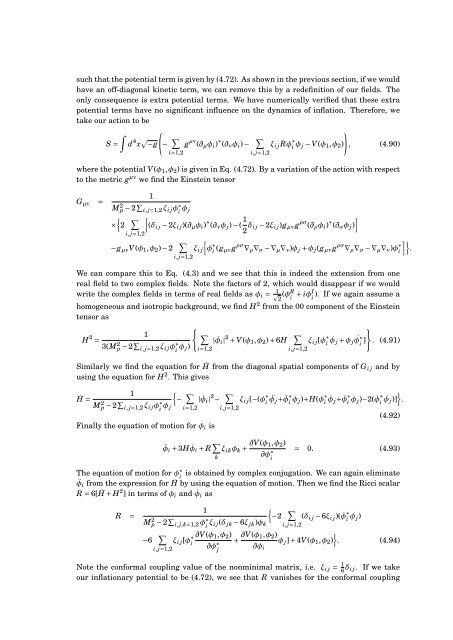Master's Thesis in Theoretical Physics - Universiteit Utrecht
Master's Thesis in Theoretical Physics - Universiteit Utrecht
Master's Thesis in Theoretical Physics - Universiteit Utrecht
Create successful ePaper yourself
Turn your PDF publications into a flip-book with our unique Google optimized e-Paper software.
such that the potential term is given by (4.72). As shown <strong>in</strong> the previous section, if we wouldhave an off-diagonal k<strong>in</strong>etic term, we can remove this by a redef<strong>in</strong>ition of our fields. Theonly consequence is extra potential terms. We have numerically verified that these extrapotential terms have no significant <strong>in</strong>fluence on the dynamics of <strong>in</strong>flation. Therefore, wetake our action to be∫S =d 4 x −g(− ∑i=1,2g µν (∂ µ φ i ) ∗ (∂ ν φ i ) −∑i, j=1,2ξ i j Rφ ∗ i φ j − V (φ 1 ,φ 2 )), (4.90)where the potential V (φ 1 ,φ 2 ) is given <strong>in</strong> Eq. (4.72). By a variation of the action with respectto the metric g µν we f<strong>in</strong>d the E<strong>in</strong>ste<strong>in</strong> tensorG µν =1M 2 p − 2 ∑ i, j=1,2 ξ i j φ ∗ i φ j×{2 ∑ [(δ i j − 2ξ i j )(∂ µ φ i ) ∗ (∂ ν φ j ) − ( 1 ]2 δ i j − 2ξ i j )g µν g ρσ (∂ ρ φ i ) ∗ (∂ σ φ j )i, j=1,2−g µν V (φ 1 ,φ 2 ) − 2∑i, j=1,2ξ i j[φ ∗ i (g µν g ρσ ∇ ρ ∇ σ − ∇ µ ∇ ν )φ j + φ j (g µν g ρσ ∇ ρ ∇ σ − ∇ µ ∇ ν )φ ∗ i]}.We can compare this to Eq. (4.3) and we see that this is <strong>in</strong>deed the extension from onereal field to two complex fields. Note the factors of 2, which would disappear if we wouldwrite the complex fields <strong>in</strong> terms of real fields as φ i = 1 (φ R + iφ I ). If we aga<strong>in</strong> assume a2 i ihomogeneous and isotropic background, we f<strong>in</strong>d H 2 from the 00 component of the E<strong>in</strong>ste<strong>in</strong>tensor as{H 2 1∑=3(M 2 p − 2 ∑ i, j=1,2 ξ i j φ ∗ i φ | φ˙i | 2 + V (φ 1 ,φ 2 ) + 6H∑ξ i j [φ ∗ iφ˙j + φ j φ˙}. ∗ ij)] (4.91)i=1,2i, j=1,2Similarly we f<strong>in</strong>d the equation for Ḣ from the diagonal spatial components of G i j and byus<strong>in</strong>g the equation for H 2 . This gives1Ḣ ={− ∑M 2 p − 2 ∑ i, j=1,2 ξ i j φ ∗ i φ | ˙φi | 2 − ∑ji=1,2F<strong>in</strong>ally the equation of motion for φ i isi, j=1,2ξ i j [−(φ ∗ ¨iφ j + ¨φ∗i φ j)+H(φ ∗ i ˙φ}j + ˙φ∗i φ j)−2( ˙φ∗ ˙iφ j )] .(4.92)¨φ i + 3H ˙φi + R ∑ kξ ik φ k + ∂V (φ 1,φ 2 )∂φ ∗ i= 0. (4.93)The equation of motion for φ ∗ iis obta<strong>in</strong>ed by complex conjugation. We can aga<strong>in</strong> elim<strong>in</strong>ate¨φ i from the expression for Ḣ by us<strong>in</strong>g the equation of motion. Then we f<strong>in</strong>d the Ricci scalarR = 6[Ḣ + H 2 ] <strong>in</strong> terms of φ i and ˙φi asR =1{M 2 p − 2 ∑ i, j,k=1,2 φ ∗ i ξ −2i j(δ jk − 6ξ jk )φ k−6∑i, j=1,2ξ i j [φ ∗ ∂V (φ 1 ,φ 2 )i∂φ ∗ j∑i, j=1,2(δ i j − 6ξ i j )( ˙φ∗ φ˙j )+ ∂V (φ 1,φ 2 )∂φ iφ j ] + 4V (φ 1 ,φ 2 )i}. (4.94)Note the conformal coupl<strong>in</strong>g value of the nonm<strong>in</strong>imal matrix, i.e. ξ i j = 1 6 δ i j. If we takeour <strong>in</strong>flationary potential to be (4.72), we see that R vanishes for the conformal coupl<strong>in</strong>g
















